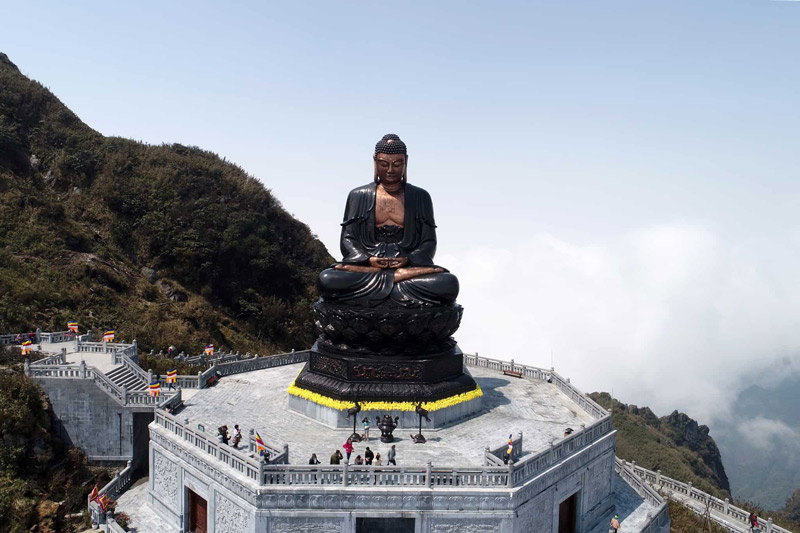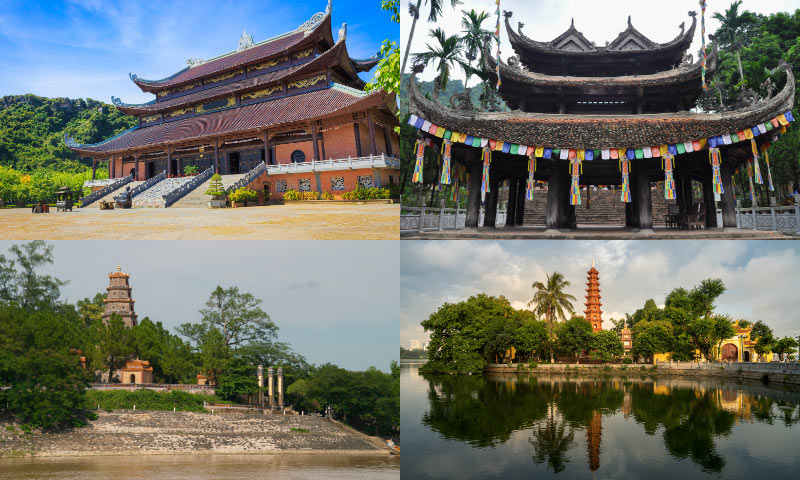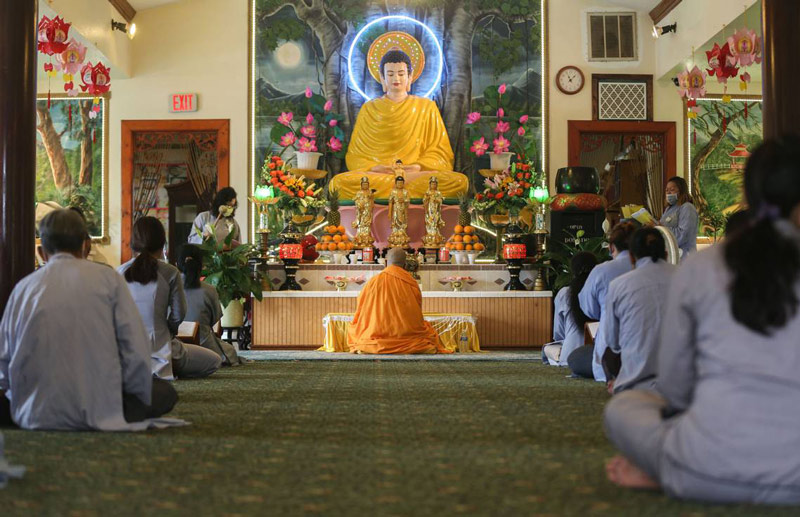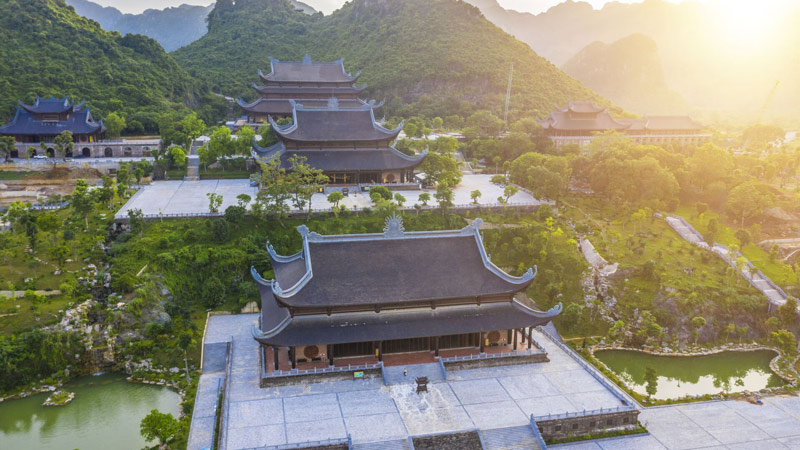Buddhist Temple in Vietnam: Finding Peace and Enlightenment Amidst Beauty
Amidst Vietnam's vibrant landscapes and rich cultural tapestry, the serene and spiritually charged ambiance of its ancient Buddhist heritage stands prominently.The country's Buddhist temples, standing as monumental beacons of tranquility, spirituality, and cultural heritage, invite visitors into a world where ancient philosophy and architectural splendor converge. These temples, serving as spiritual centers, historical landmarks, and cultural hubs, offer a unique window into the Vietnamese way of life, weaving together the threads of tradition, devotion, and communal harmony. This journey into Vietnam's sacred spaces reveals not only their architectural beauty and spiritual significance but also their enduring impact on the cultural and social fabric of the nation.
1. A Spiritual Sanctuary: The Heart of Vietnamese Buddhism

In the vibrant cultural tapestry of Vietnam, the serene presence of Buddhist temples stands as a testament to the enduring spiritual tradition that has shaped the country's identity for centuries. These temples, or pagodas as they are locally known, serve not only as architectural marvels but also as the epicenter of spiritual life for many Vietnamese people. The Vietnam Buddha temple, in its various manifestations from the ornate to the austere, invites followers and visitors alike into a realm of tranquility and contemplation.
The role of the Vietnam Buddhist temple transcends the physical boundaries of its structure, offering a sanctuary for worship, meditation, and the pursuit of mindfulness. These sacred spaces are dedicated to the veneration of the Buddha and are imbued with the profound spiritual heritage of Vietnam. Devotees frequent these temples to engage in prayer ceremonies, seeking guidance, blessings, and the wisdom of the Buddha's teachings. The air inside a temple is thick with the scent of incense, a symbolic offering that represents the devotee's purity, devotion, and the impermanence of life.
Beyond the rituals and the ceremonial, the Vietnam Buddha temple plays a crucial role in the cultivation of inner peace and mindfulness among its followers. It offers a respite from the hustle and bustle of daily life, inviting individuals to slow down, reflect, and connect with their inner selves. Meditation sessions, often led by resident monks, provide practical guidance in the art of mindfulness, teaching attendees how to live in the present moment, acknowledge their thoughts and emotions without judgment, and cultivate a sense of peace and well-being.
The importance of these temples in Vietnamese life cannot be overstated. They are not only places of worship and spiritual practice but also centers for community gathering and cultural preservation. The Vietnam Buddhist temple is a beacon of peace, offering a pathway to enlightenment and a refuge for those seeking solace and introspection. Through offerings, prayer ceremonies, and the practice of meditation, these temples uphold the timeless quest for inner peace, guiding individuals on their spiritual journey towards mindfulness and liberation.
In essence, the Vietnam Buddha temple embodies the spiritual heritage of Vietnam, playing a pivotal role in the lives of its people. As places of worship, meditation, and community, these temples stand as sanctuaries of peace, inviting all who enter to embark on a profound journey of self-discovery and spiritual awakening.
2. Architectural Splendor: Vietnamese Buddhist Temples

The architectural beauty of Vietnamese Buddhist temples is a captivating synthesis of spiritual symbolism and natural harmony. These serene sanctuaries, nestled amidst Vietnam's lush landscapes, stand as monuments to the country's rich cultural and religious heritage. At the heart of their design is a profound respect for the natural world, manifesting through the extensive use of organic materials and the integration of the surrounding environment into the spiritual experience.
2.1. Natural Materials: The Foundation of Serenity
Traditionally, Vietnamese Buddhist temples are constructed using locally sourced materials that speak to the earth's enduring presence. Wood and brick are the cornerstones of these sacred structures, each chosen for their natural beauty and durability. The wooden components are often left in their natural state or treated to highlight their intrinsic patterns, adding warmth and a sense of welcoming to the temple interiors. Bricks, on the other hand, are used to create intricate patterns on floors and walls, embodying the temple's connection to the earth.
2.2. Distinctive Tiered Roofs: Reaching for the Divine
One of the most striking features of Vietnamese Buddhist temples is their distinctive tiered roofs. These elegant structures, characterized by an upward curvature at the edges, are not just visually stunning; they symbolize the temple's reach towards the heavens. The layers of the roof often feature intricate carvings of dragons, phoenixes, and other mythological creatures, each a guardian of the temple's sanctity. The vibrant colors and detailed craftsmanship serve as a visual mantra, guiding the mind towards contemplation and reverence.
2.3. Vibrant Colors and Intricate Carvings: A Visual Feast
The use of vibrant colors and intricate carvings is another hallmark of Vietnamese Buddhist temple architecture. Walls, columns, and beams are adorned with detailed carvings that tell stories from Buddhist lore, representing teachings, virtues, and the eternal cycle of life. The colors used are not arbitrary; each hue holds symbolic meaning, with gold representing purity and enlightenment, red symbolizing luck and prosperity, and green denoting peace and harmony. Together, these elements create a visually rich environment that stimulates the senses and uplifts the spirit.
2.4. Courtyards, Gardens, and Water Features: Spaces of Reflection
The importance of courtyards, gardens, and water features in Vietnamese Buddhist temples cannot be overstated. These open spaces are integral to the temple's design, offering devotees and visitors alike areas for meditation, reflection, and communion with nature. Courtyards often feature carefully manicured gardens, with bonsai trees and flowering plants that add to the temple's tranquil atmosphere. Water features, such as lotus ponds and fountains, are common, symbolizing purity, renewal, and the flow of life. The gentle sound of water, combined with the natural beauty of the gardens, creates a peaceful oasis that enhances the spiritual ambiance of the temple.
3. Famous buddhist temple in Vietnam

Bai Dinh Pagoda (Ninh Binh): Bai Dinh is the largest Buddhist complex in Southeast Asia, sprawling across a vast area of hills and valleys. Its impressive size is matched by its ornate architecture, featuring massive bronze statues, intricate carvings, and colorful murals. The main pagoda houses a giant bronze Buddha, while the surrounding grounds include several smaller temples, gardens, and a stupa.
Perfume Pagoda (Hanoi): A pilgrimage site steeped in history and natural beauty, the Perfume Pagoda is reached by boat through a scenic river and limestone cave system. The main complex, nestled in the mountains, consists of several pagodas, temples, and shrines built into the rock face. It's particularly popular during the Perfume Pagoda Festival, held annually from January to March.
One Pillar Pagoda (Hanoi): An iconic symbol of Hanoi, the One Pillar Pagoda is a small but elegant structure built on a single stone pillar in the middle of a lotus pond. Its unique architecture is inspired by a lotus flower, representing purity and enlightenment. The pagoda has been rebuilt several times due to damage, but it retains its original design and cultural significance.
Tran Quoc Pagoda (Hanoi): Located on a small island in West Lake, Tran Quoc is the oldest pagoda in Hanoi, dating back to the 6th century. It's known for its beautiful setting, serene atmosphere, and impressive collection of bonsai trees. The pagoda's multi-tiered tower and surrounding buildings are adorned with intricate carvings and statues.
But Thap Pagoda (Bac Ninh): But Thap is celebrated for its unique architectural style, blending elements of Vietnamese and Chinese influences. The pagoda's centerpiece is a towering octagonal tower, intricately carved with scenes from Buddhist mythology. The surrounding complex includes several smaller temples, pavilions, and gardens.
Giac Lam Pagoda (Ho Chi Minh City): As the oldest pagoda in Ho Chi Minh City, Giac Lam is a tranquil oasis in the bustling metropolis. Its traditional wooden architecture, peaceful gardens, and ancient bodhi tree create a serene atmosphere. The pagoda houses a valuable collection of Buddhist statues and artifacts.
Vinh Trang Pagoda (Tien Giang): Vinh Trang is a unique blend of Vietnamese, Cambodian, and European architectural styles, resulting in a visually striking complex. The pagoda's intricate carvings, colorful mosaics, and ornate statues are a testament to its rich history and cultural significance.
Thien Mu Pagoda (Hue): Perched on a hill overlooking the Perfume River, Thien Mu is one of Hue's most iconic landmarks. Its seven-story octagonal tower is the tallest in Vietnam, symbolizing the seven steps of enlightenment. The pagoda complex includes several other buildings, gardens, and a turtle sanctuary.
Linh Phuoc Pagoda (Da Lat): Linh Phuoc, also known as the "Dragon Pagoda," is famous for its colorful mosaics made from broken glass and pottery. The pagoda's architecture and decorations are a unique blend of Vietnamese folk art and Buddhist symbolism. Its main hall houses a giant white Buddha statue.
Truc Lam Zen Monastery (Lam Dong): Nestled in the pine forests of Da Lat, Truc Lam is a serene Zen monastery offering a peaceful retreat from the city. Its traditional architecture, tranquil gardens, and meditation halls provide a conducive environment for reflection and spiritual practice.
4. Experiencing and Temple Etiquette for Travelers

Exploring the serene beauty of Buddhist temples in Vietnam offers not just a glimpse into the country's spiritual heart, but also an opportunity to engage with its rich cultural tapestry. To ensure that this interaction is both respectful and enriching, adhering to certain etiquettes is essential. Here’s a practical guide to help tourists navigate the sacred spaces with due reverence.
Dress Modestly: First impressions matter, and in the context of a Buddhist temple, how you dress significantly influences the respect you show towards the sacred premises and its followers. Ensure your attire covers your shoulders and knees. Loose-fitting, long clothes not only comply with the decorum but also help you blend in more comfortably with the temple’s tranquil atmosphere.
Removing Shoes Before Entering Prayer Halls: In many cultures, removing shoes before entering a home is a sign of respect. The same applies to Buddhist temples, especially when entering prayer halls. This practice symbolizes leaving the dust and dirt of the outside world behind, both literally and metaphorically, as you enter a space of purity and sanctity.
Maintain a Quiet and Respectful Demeanor: Temples are oases of peace and meditation. Maintaining a quiet and respectful demeanor not only shows your respect for those in prayer and meditation but also enhances your own experience of the temple’s serene environment. Speak in low tones if you need to communicate, and ensure your mobile devices are silenced to preserve the atmosphere of tranquility.
Photography Guidelines: While many temples allow photography, it’s crucial to do so mindfully. Avoid using flash as it can be disruptive and disrespectful, particularly during prayer ceremonies or in dimly lit areas where the ambiance is part of the spiritual experience. Always look for signs indicating whether photography is permitted, and when in doubt, ask a temple official for guidance.
Engage Respectfully with the Temple Environment: Buddhist temples offer rich insights into Vietnamese spiritual life and traditions. Tourists are encouraged to engage with the environment respectfully by:
Observing Prayer Ceremonies Silently: Witnessing these ceremonies can be a profoundly moving experience. Do so silently, and maintain a respectful distance to avoid disturbing the participants.
Learning About Buddhist Statues and Symbols: Many temples have information plaques or offer guided tours that explain the significance of various statues and symbols. Take the opportunity to learn; understanding these elements can deeply enrich your visit.
Participating in Meditation Sessions: If offered, participating in a meditation session can be a highlight of your temple visit. It’s not only a unique cultural experience but also an opportunity to find personal peace and introspection within the sacred space.
Visiting a Buddhist temple in Vietnam is a privilege that comes with the responsibility to act with mindfulness and respect. By following these simple guidelines, tourists can ensure their visit is both enjoyable and harmonious, contributing positively to the sanctity of these spiritual havens.
5. Discovering Peace and Beauty in Vietnam's Buddhist Temples

Visiting a Buddha temple in Vietnam transcends mere sightseeing; it is an enriching journey into the spiritual heart of the country. These sacred spaces offer more than just an opportunity to admire intricate architecture and ancient relics; they invite you into a world of tranquility, reflection, and deep cultural immersion. Each Buddhist temple in Vietnam stands as a testament to the nation's enduring faith and its artistic heritage, making them must-visit destinations for anyone seeking to understand the essence of Vietnamese spirituality.
The experience of stepping into a Buddhist temple in Vietnam is to embark on a journey of learning and personal growth. It's a chance to delve into the teachings of Buddhism, to witness the devout practices of monks and laypeople, and to soak in the serene atmosphere that pervades these holy sites. Beyond spirituality, these temples are treasure troves of cultural beauty, from their awe-inspiring pagodas reaching towards the sky to the tranquil Zen gardens that invite contemplation. Here, amid the whispers of incense and the soft chants of prayers, moments of peace find you, offering a rare chance to pause and reflect away from the hustle and bustle of daily life.
For those inspired to explore these spiritual landmarks, Vietnam is home to many famous Buddhist temples that each offer a unique glimpse into the nation’s soul. The tranquil Thien Mu Pagoda in Hue, with its iconic seven-story tower, offers breathtaking views of the Perfume River. The sprawling Bai Dinh Temple complex in Ninh Binh, known for housing the largest Buddha statue in Southeast Asia, is a testament to the grandeur of Vietnamese Buddhism. And in the heart of Ho Chi Minh City, the Vinh Nghiem Pagoda stands as a modern marvel of Buddhist architecture, seamlessly blending traditional motifs with contemporary design.
In conclusion, a visit to the Buddhist temples in Vietnam is not merely a tourist activity; it is an invitation to explore the depth of Vietnamese culture, spirituality, and beauty. Whether you are drawn to Buddhism or simply wish to experience the peace and artistry of these sacred sites, Vietnam's Buddhist temples offer a profound and unforgettable journey.
The best articles
- Vietnamese Fruits: A Tropical Exotic World of Flavor
- Bamboo Rafting in Vietnam: A Tranquil Adventure Through Nature's Beauty
- Vietnam's Open Secret: Discover the Welcoming Soul of Vietnamese People
- The Road Less Traveled: Your Guide to Unforgettable Things to Do in Kon Tum
- Vietnam Breakfast Delights: A Culinary Journey to Start Your Day
- The Ultimate Guide to Vietnamese Noodles: A Symphony of Flavors, Textures, and Traditions
- Vietnam Beer: Discovering Unique Flavors and Cultural Significance
- Top Things to Do in Lao Cai: From Fansipan Peak to Authentic Villages
- Vietnamese Candy: Where Sweet Meets Surprising
- Exploring the Beauty of Silver Waterfall Sapa: A Must-Visit Natural Attraction